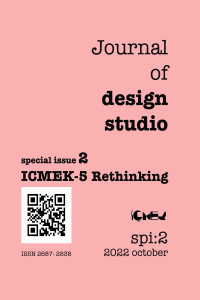Vertical Design Studio in Architectural Education: A Summer Practice on Corner Parcel
Vertical Design Studio in Architectural Education: A Summer Practice on Corner Parcel
This study discusses the experience of a vertical studio implemented at SCU Department of Architecture. The goal of such an experiment is to open channels of interaction in the studio and activate peer learning. This vertical studio, which was carried out within the scope of the 2021-2022 academic year summer school, includes three different project groups from the second, third and fourth grades. Studio participants with different individual experiences were presented with a main theme focusing on ‘corner’ concept. To diversify contextual openings, four different definitions of ‘corners’ in urban space were developed, and students were free in terms of space selection, architectural program and other design dynamics. While producing projects in the studio around ‘corner’ comprehension, the studio process was observed in terms of activities such as interaction, dialog, collaboration and peer learning. As a result, it was determined that the understanding of dialog and collaborative work for discussing the main theme and/or design decisions has not yet been established, while at the same time it has been understood that vertical studio is a practice that eliminates class-level boundaries and makes the studio open and accessible.
Keywords:
Architectural Education, Corner parcel, Corner building Design, Vertical studio,
___
- Akalın, A. & Sezal, İ. (2009). The importance of conceptual and concrete modelling in architectural design education. The International Journal of Art & Design Education, 28(1), 14-24.
- Çağlar, N. & Sönmez, M. (2009). Mimari tasarım eğitiminin düşündüren/tartıştıran durumları: Mimari tasarım stüdyosu ortamlarının güncellenmesi bağlamında bütünleşme/yeniden-bütünleşme yaklaşımları. In F. R. Ünver, Ç. Polatoğlu, S. M. Vural & H. Düzgün (Eds.), Mimari Tasarım Eğitimi’09: “Bütünleşme” Symposium Communiques (pp. 2-4). İstanbul: Yıldız Teknik Üniversitesi Mimarlık Fakültesi.
- Çağlar, N. & Uludağ, Z. (2006). Architectural design education: Designing a library, public communication and information center in the manufacturing zone of central Eskişehir Turkey, a case study. The International Journal of Art & Design Education, 25(2), 231-240.
- Giencke, A. (2021). Vertical Studio: Undergraduate Collaborative Advanced Learning and Teaching Methodology. Cubic Journal, (4), 100-107.
- Ismail, A. M. & Soliman, M. H. (2010). Integrating multi-grade collaborative learning pedagogy into design studios. ArchNet-IJAR: International Journal of Architectural Research, 4(2/3), 201.
- Knorr Cetina, K. (1999). Epistemic Cultures: How the Sciences Make Knowledge. Cambridge, MA: Harvard University Press.
- Kurath, M. (2015). Architecture as a science: Boundary work and the demarcation of design knowledge from research. Science & Technology Studies, 28(3), 81-100.
- McLaughlan, R. & Chatterjee, I. (2020). What works in the architecture studio? Five strategies for optimising student learning. The International Journal of Art & Design Education, 39(3), 550-564.
- Michels, M. & Meeus, W. (2013). A sentiment for architecture. In E. De Vos, J. De Walsche, M. Michels & S. Verbruggen (Eds.), Proceedings of the Conference on Theory by Design (pp. 191-196). Belgium: The Faculty of Design Sciences, Artesis University College, Antwerp University Association.
- Özbek, D. A., Eke, A. S. M., Yücesan, E. & Ozar, B. (2018). Vertical design studio experience in interior architecture education. Online Journal of Art and Design, 6(2), 159-175.
- Peterson, M. & Tober, B. (2014). Institutionalizing the vertical studio: Curriculum, pedagogy, and the logistics of core classes with mixed-level students. Connecting Dots: Research, Education + Practice (pp. 138–144). Cincinnati, OH: University of Cincinnati.
- Schaeverbeke, R. & Heylighen, A. (2013). Drawing and designing as a research approach to rethink teaching. In E. De Vos, J. De Walsche, M. Michels & S. Verbruggen (Eds.), Proceedings of the Conference on Theory by Design (pp. 159-166). Belgium: The Faculty of Design Sciences, Artesis University College, Antwerp University Association.
- Smatanová, K., Gregor, P. & Šeligová, A. (2020). Pros and cons of the vertical and horizontal design studios in architects’ education. Global Journal of Engineering Education, 22(3).
- UNESCO-UIA. (2017). Charter for Architectural Education, Revised, 2017 Edition. Erişim Tarihi 10 Haziran 2022, https://www.uia-architectes.org/wp-content/uploads/2022/02/Architectural-Education Charter_2017_english.pdf
- Van Dooren, E. J. G. C., Van Merriënboer, J., Boshuizen, H. P. A., Van Dorst, M. & Asselbergs, M. F. (2018). Architectural design education: in varietate unitas. International Journal of Technology and Design Education, 28, 431-449.
- Van Dooren, E., Boshuizen, E., van Merriënboer, J., Asselbergs, T. & van Dorst, M. (2014). Making explicit in design education: Generic elements in the design process. International Journal of Technology and Design Education, 24, 53-71.
- Yayın Aralığı: Yılda 2 Sayı
- Başlangıç: 2019
- Yayıncı: Orhan HACIHASANOĞLU
Sayıdaki Diğer Makaleler
An Online Basic Design Studio Experience: From Point to Space
Teaching Ergonomics in the Online Studio
Shaping Sustainability in Architectural Education : The Integrated Design as a tool.
Khansa DHAOUADİ, Pierre LECLERCQ
Hayriye Yasemin SOYLU, Berrak KARACA ŞALGAMCIOĞLU, Kübra BIYUK ÖKSÜZ
Visual Spaces of Change: Self-reflection on Architecture and Urban Change Through Photography
Vertical Design Studio in Architectural Education: A Summer Practice on Corner Parcel
#eindakoa (what we have done): A Pedagogical Method of Interior Design Studio Method
